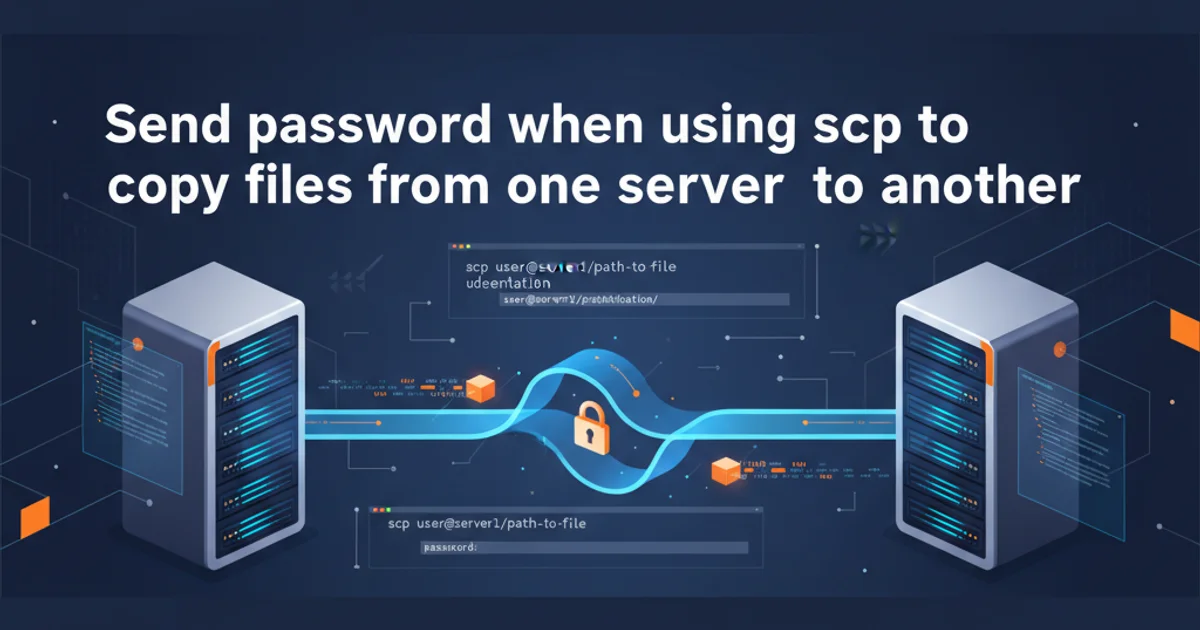Send password when using scp to copy files from one server to another
Categories:
Securely Transferring Files with SCP: Handling Passwords

Learn how to use scp for file transfers between servers, focusing on secure password handling and alternative authentication methods for automation.
Secure Copy Protocol (scp) is a command-line utility that allows you to securely copy files and directories between local and remote hosts, or between two remote hosts. It uses SSH for data transfer and provides the same authentication and security as SSH. While scp is powerful, directly providing a password on the command line is generally discouraged due to security risks. This article will explore various methods for handling passwords with scp, including less secure but sometimes necessary direct input, and more secure automated approaches.
Basic SCP Usage and Password Prompt
The most straightforward way to use scp is to simply execute the command. When you do this, scp will prompt you for the password of the remote user. This is the standard and most secure interactive method, as your password is not exposed in your shell history or process list.
scp /path/to/local/file user@remote_host:/path/to/remote/directory
# You will be prompted for the password after executing this command.
Basic SCP command prompting for password
-r (recursive) option: scp -r /path/to/local/dir user@remote_host:/path/to/remote/parent_dir.Automating SCP with Passwords (Less Secure)
In some specific scenarios, you might need to automate scp operations where interactive password entry is not feasible. Directly embedding passwords in scripts is a significant security risk and should be avoided if possible. However, if absolutely necessary, tools like sshpass can be used. sshpass allows you to provide the password as an argument or from a file, which then gets passed to the scp command.
sshpass or similar methods to provide passwords directly is highly insecure. The password can be exposed in process lists, shell history, or log files. Prioritize SSH key-based authentication for automation.# Install sshpass first (e.g., sudo apt-get install sshpass on Debian/Ubuntu)
# Method 1: Password directly in command (HIGHLY INSECURE)
sshpass -p 'your_password' scp /path/to/local/file user@remote_host:/path/to/remote/directory
# Method 2: Password from a file (still insecure, but slightly better than direct command)
echo 'your_password' > password.txt
sshpass -f password.txt scp /path/to/local/file user@remote_host:/path/to/remote/directory
rm password.txt # Delete the password file immediately after use
Using sshpass for automated SCP with passwords
Recommended: SSH Key-Based Authentication
The most secure and recommended way to automate scp (and SSH) without interactive password prompts is to use SSH key pairs. This involves generating a public/private key pair, placing the public key on the remote server, and using the private key for authentication. This method eliminates the need to ever type a password for automated scripts and is significantly more secure.
flowchart TD
A[Local Machine] --> B{Generate SSH Key Pair}
B --> C[Private Key (id_rsa)]
B --> D[Public Key (id_rsa.pub)]
D --> E[Remote Server]
E --> F{Append Public Key to ~/.ssh/authorized_keys}
A -- "scp -i ~/.ssh/id_rsa" --> E
F -- "Authentication without password" --> AProcess for SSH Key-Based Authentication with SCP
1. Generate SSH Key Pair
On your local machine, open a terminal and run ssh-keygen. Press Enter to accept the default file location and an empty passphrase (unless you specifically need one for extra security, which would require entering it once per session).
2. Copy Public Key to Remote Server
Use ssh-copy-id to securely transfer your public key to the remote server. This command will prompt you for the remote user's password once, then set up the key for passwordless login. If ssh-copy-id is not available, you can manually copy the content of ~/.ssh/id_rsa.pub to ~/.ssh/authorized_keys on the remote server.
3. Test Passwordless SCP
After copying the public key, you should be able to use scp without being prompted for a password. Try copying a small file to confirm the setup.
# Step 1: Generate key pair (if you don't have one)
ssh-keygen
# Step 2: Copy public key to remote server
ssh-copy-id user@remote_host
# Step 3: Use scp without password
scp /path/to/local/file user@remote_host:/path/to/remote/directory
Commands for setting up and using SSH key-based authentication
~/.ssh/my_custom_key), you'll need to specify it with the -i option: scp -i ~/.ssh/my_custom_key /path/to/file user@remote_host:/path/to/dir.